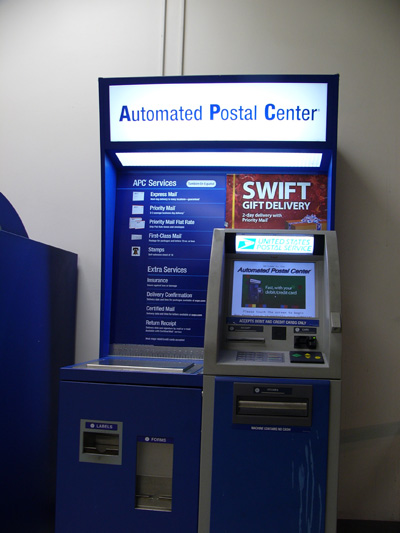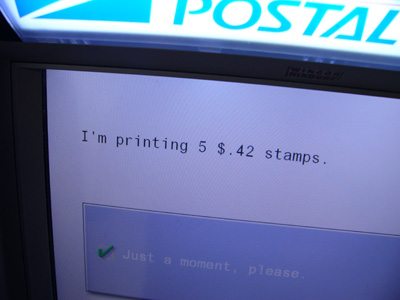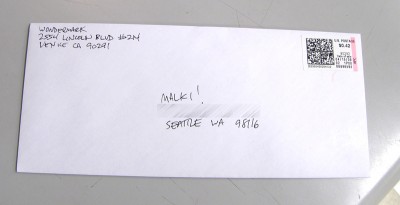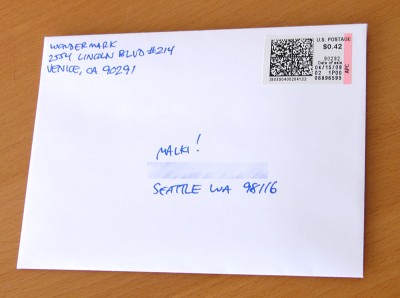Every year, on April 15, I see long lines at the post office as people wait to send in their payment, and similarly at other times of year when corporate taxes and other deadline-specific filings come due. Now, most of these people are certifying or registering their mail, and thus require a visit to the retail counter. But last year I overheard the following exchange just as the post office was closing at 7PM:
CUSTOMER: I need to get this postmarked by today!
EXHAUSTED CLERK: No. We’re closed. You need to go to the main depot [8 miles away], they’re open till 11.
CUSTOMER: It’s already stamped! Can’t you just cancel the stamp for me? It’ll take two seconds!
EXHAUSTED CLERK: Sir, we’re closed. You need to go to the depot.
This was a person who didn’t need the added certainty of registered or certified mail; he just wanted to get his check out before the deadline. All he wanted was a postmark reading April 15.
While this exchange was occurring, I was staring directly at this:

This is the Automated Postal Center. It prints stamps. Stamps with dates on them.
My neighborhood post office has an APC in a 24-hour-accessible lobby. Before I got the Endicia system to print postage at home, I often went to the APC to mail packages in the middle of the night. Any stamp bought before midnight is printed with that day’s date.
One day I realized that all the packages I was mailing weren’t being processed until the following day, and thus their stamps were a full day old. This didn’t seem to be a problem — in fact, now, in the course of my business, I often print stamps on a Friday or Saturday that don’t get mailed until Monday, and I’ve never had any sort of problem.
And then came the day when I realized I hadn’t sent a rent check yet, and it was already the evening of the third — the last postmark day before my landlord charges a late fee. I was out running errands, so I stopped by the post office, printed a stamp from the APC, and took it home. The next morning (the fourth), I mailed the check — the idea being that as far as my landlord knew, it was mailed on time.
Let me repeat this for emphasis: Nobody knew that I hadn’t actually mailed the check on the day I was supposed to. I’ll also clarify that rarely had I ever seen APC stamps, especially on packages, be canceled — so, often, the only date on the envelope would be the date printed on the stamp.
So last April, as I watched the long lines of people wait to mail their taxes, I thought: How many days after April 15 could you still send a tax form with an April 15 stamp? In other words, could you print out an April-15 stamp, go home and finish your taxes, then actually mail the check a week later? Would that work? Or would there be an additional postmark added? Would the letter even arrive?
Let me take time out here for a sanity-check caveat. I am not suggesting that you mail your taxes late, or that this method is in any way reliable or a substitute for doing things correctly. Still, I was curious. So I did the following experiment:
On April 15 of this year, I went to my local APC at 10:30 PM, long after the actual post office had closed. My intent was to buy ten first-class stamps and mail them in succession, seeing how old the stamps would have to be before the letters would start being returned, as well as whether or not they would be canceled with an additional, dated postmark.
The APC has a few purchasing restrictions. One of them is that you can’t make a single purchase for less than a dollar. If you try to buy first-class stamps, it’ll default to a minimum purchase of a dollar rather than let you buy a 44¢ (or, at the time, 42¢) stamp. Anticipating this, I’d brought along a package that needed to be shipped, and bought that (two-dollar-something) stamp first. After that purchase, the APC asked if I’d like to charge something else to the same card, and I said yes. Because I did!
Another restriction is that you can only buy five stamps at a time for the same value. My intent was to buy ten, so I bought two batches of five:

Soon, I had ten first-class stamps, all dated April 15:
I figured that to really put these stamps to the test, I should send the letters to an address relatively far away — to make sure it went through a lot of depots, verification centers, biometric drug-sniffers, or whatever. I don’t know how this stuff works; I assumed the barcode encoded a lot of crucial information about where the letter came from, where it was going, and how long the stamp should be honored. So I arranged with friends a thousand miles away (in Seattle) to receive the letters, and as a control subject, sent one letter that night of April 15:
The next letter was sent the next day:
…And so on, at increasing intervals of time, through April 29, a full two weeks after the date of the stamp. I expected that letters sent in the first week or so would arrive, and then they’d start coming back.
I was wrong. They all made it.
Three to five days after each letter was sent from Los Angeles, it arrived in Seattle. I happened to be going to Portland, Oregon during the trial period, so I sent one letter from there; despite the “from a California ZIP code” embedded in the barcode, it made it to Seattle just fine.
Now, perhaps this isn’t so surprising. After all, a stamp is a stamp, and most letters and packages fly through the postal system without anybody second-guessing them. I was clearly wrong about there being a system of CIA-grade laser scanners checking every barcode on every letter for anything awry, but really, that was wishful thinking on my part. I began to tear up my 24 fanfic. Bauer would never follow that last remaining lead now! And the conspiracy threatened to go all the way to the Postmaster General.
The interesting part was that, as predicted, not all of the stamps arrived with cancellations. Of the ten sent to Seattle, only six arrived there canceled — meaning that four envelopes (40%) arrived indicating only the April 15 date and no other postmark.
I had my friend put a new address label on those four envelopes and drop ’em back in the mail — and they all made it back to me in Los Angeles just fine. Now we had letters being sent successfully over a month after the date on the stamp, to say nothing of these stamps having been used twice with no problems. Roughly the same ratio of this second set arrived with cancellations: only two out of the four, or 50%.
Then, in May, the postal rates went up. One-ounce first-class mail increased to 44¢, instead of the 42¢ I had paid. Like the “Forever” stamps, I wondered if the two remaining un-canceled stamps held their value. So two weeks ago, while in San Diego for Comic-Con, I re-mailed the two remaining un-canceled letters, now hoping for a third trip on each stamp. Did they arrive safely? Any guesses?
Of course they did, just a few days later. And again, only 50% (one out of the two — I know it’s hardly statistically significant, but still) arrived canceled. Both were sent in July (a week apart), over three months after the date on the stamp, a hundred miles away from the ZIP code where each stamp was purchased for 2¢ less than the current first-class rate. What is that bar code for, I wonder?
The moral of the story? Perhaps it’s that the Post Office is forgiving. Maybe it’s that those APC stamps last forever. I wouldn’t necessarily use them for time-sensitive stuff like taxes, because you’re definitely playing the odds against having the stamp canceled with an official, dated postmark. But in a pinch, I wouldn’t toss the idea out the window either.
I still have one stamp from April 15 that, as far as I know, is still good. Maybe I’ll keep it safe, and mail myself something every April 15 for years to come until its luck finally runs out and it’s canceled. Or if I don’t, then maybe I can imagine that this is the Lucky Stamp. A hero stamp. Immune. A three-time mail traveler, weathered with toil and still valid besides. How many stamps in history can claim that?





I’d guess that the coded area is some sort of encryption that verifies it is a stamp, so that you can’t print just anything there. The time and location of printing are probably included, as well as something unique(-ish) that allows for tracking. That is, if you copied one of those stamps many times, some part of the system would catch it.
The issue of stamps not being canceled has existed for a long time. I believe it is a crime to re-use a stamp, and since it’s the USPO, probably a federal crime. It’s a hard case to prove unless you really abuse it… or admit it on your web site.
I noticed this about a year ago when I mailed a small package using the APC and it didn’t quite cost a dollar. I got a first class stamp to bring it over $1. I just gave someone the stamp to send something, and as far as I know, it worked.
If I had to guess, I’m guessing that they are only physically cancelled if the barcode scanner system is down. I’m also guessing they keep electronic records of when each stamp was scanned, so if you wound up in a legal spat over the postmark date, the USPS could verify when it was actually sent.
It seems like a similar problem exists with metered mail. You could simply print metered postage on a bunch of envelopes and send them at a later date. So, it seems like the problem is old enough that they have some way of dealing with it.
That… that’s brilliant. 🙂
Um, didn’t you just admit, with photographic evidence, to multiple counts of mail fraud, a federal felony?
The smart money says take this posting down right quick.
Excellent experiment! Too bad the about the 50% (apparent) chance of cancellation for those would-be late fee avoiders out there.
My wife has been using 42 cent stamps for the past couple of months and only realized last week that the rate increased to 44 cents. [I mean, seriously, who checks the USPS site every few weeks to see if they’ve raised prices AGAIN?] Two weeks ago she mailed out 50 shower invitations and not one of them was returned for additional postage.
When we went to the post office we asked the clerk if they would continue accepting the 42 cent stamps without additional postage and he responded, and I quote, “No one here cares about that unless they are complete dicks”.
That guy was awesome.
To me, it seems like another way to get around “Poor Man’s Copyright.”
http://www.copyrightauthority.com/poor-mans-copyright/
Although, this warning poster from the USPS is pretty on-topic
http://www.usps.com/cpim/ftp/posters/pos5.pdf
“WARNING
Once a postage stamp has been used, it is a fedral crime to:
1. Remove, attempt to remove, or assist to remove cancellation marks from postage.
2. Reuse a stamp whether cancelled or not.
If you have questions concerning the reuse of postage, please contact your local Postage Inspector
Title 18, U.S. Code, Sections 471 and 1720”
Seconding the mail fraud thing.
The US Postal Inspection Service is real:
http://en.wikipedia.org/wiki/United_States_Postal_Inspection_Service
And I haven’t dealt with them personally, but I understand they can be quite the bitch to deal with.
No joke, I’d probably kill this post, and be real apologetic when they call you.
“Sorry, that was stupid, I didn’t know it was a Federal Crime,” will probably cover you on this one.
I’ve actually had an opposite problem using the APC — I purchased delivery confirmation for several packages, but because the APC didn’t know that I immediately put the packages in the bin, there was no way to prove that I had indeed done it. So, when the delivery confirmation showed the packages hadn’t been delivered, I had no recourse – they hadn’t been scanned yet, so the “confirmation” screen read that the postage had been bought, but that the package hadn’t been dropped off yet. I ended up looking negligent. One package finally made its way three weeks later (even though I had paid for priority delivery.) The others were never found.
I’ve used these stamps more than a year after print date after finding them laying around my wallet. I have no way to know if it was actually canceled or not, but I would not be surprised if these never expire.
Yikes, very cool experiment. I love reading about people’s curiosity…but this does sound like mail fraud, 99% chance you are small fry, but getting noticed probably depends on how bored the inspectors are, and how much they are surfing digg.com today.
It’s clearly just an experiment; if federal mail inspectors really care about stuff like this, then their jobs are pretty useless.
I work in the mail room at a medium-sized business, and when the postage-change hit, we just kept merrily plugging along for about four days, until someone brought in some mail and wondered why our prices hadn’t gone up. We got nothing back… call it 250+ individual pieces, mainly letter-sized (1 oz, 44 cent) but a good number were either heavier or flat-rate. (I think that changed as well, but I disremember.)
Back when I was hired, I was given warning about the (never detailed or explained) dire consequences of not getting the metered mail out by the pickup time for that day; perhaps it’s not such a big deal after all?
(Note – mine isn’t APC, but a POS Pitney-Bowes postal meter that I’d like to throw in the river.)
Maybe things have changed since I was a youngster, but in the good old days, I’ve sent letters with S&H Green Stamps, stamps from book clubs and so on. ( There may have been the odd stamp from the Columbia Record Club in the mix). IIRC, they all arrived just fine.
My current mail activities are much more subtle. I don’t use it.
Regards, The Zipster
I loved the experiment.
Too Cool.
Hugs,
Lolita
The barcode is the “to” address, I believe. It helps the automated postal-sorting machine do its job.
You, sir, are the reason the Post Office is going out of business!
That, and e-mail…
I doubt the USPS would care so much about reusing $5 worth of postage, especially considering that most of it involved sending the (unopened?) letter back to yourself. What could get you in trouble, had you not included several bolded passages to the contrary, is suggesting that people reuse postage as a cost-saving measure.
Even if I didn’t receive any threatening calls, I’d still want to do something to restore cosmic balance, like giving a couple of bucks to the Postal Museum at the Smithsonian.
http://www.postalmuseum.si.edu/
Stamps in America have a use by date? That’s just weird…..
You could also just buy a few extra stamps and never use em. That way there’s no attempt at theft.
I can’t believe this! I bought an APC stamp once for when I was applying for a Japanese visa, and since I had bought it the day before, the stupid consulate wouldn’t accept the stamp, telling me that the Post Office wouldn’t accept it. I had to walk all around downtown San Francisco trying to find a Post Office, buying dozens of stamps in postage, and then put them all on the envelope before going back to the consulate. Ugh, Japanese people don’t know anything.
But now your landlord KNOWS you didn’t mail your rent check on time. What about THAT?
@Frankie D., regular stamps in the US don’t expire. These are printed from a meter and dated so Malki! was testing if the date on them meant anything. Mail from office postage meters used to be monitored, because when we’d forget to advance the date (back in the manual meter days) they would often call and chastise us since it made them look slow and we could be doing something fraudulent. Apparently, the dates on these are irrelevant.
The barcode is obviously not an address since (a) I don’t think you put those in and (b) your friend was able to return them so it wasn;’t using that as an address. My guess is that it’s simply a transaction code that IDs it as a valid stamp, since a text-only stamp would be easy to print on a home printer, inviting mail fraud too.
There are some guys here in Chicago that make “art stamps” that are most interesting when sent through the postal service and canceled. Some with guns, drugs, boobs, odd things to run through the post office. And they’ve had some nasty nasty nasty dealings with “the man”.
http://www.badpressbooks.com/mhdl.html
Umm, the IRS doesn’t have time to read cancellation dates on all the returns that show up in late April. Mail it in on April 22nd if you want to, they won’t notice or care.
A mail tactic I may try someday is to mail a letter with the return and recipient address switched. I think if you do switch the 2 addresses, and don’t put any postage on it, the mail system will return it with an “insufficient postage” notice, but it will be returned to the intended recipient. Wuddaya think?
What a great entry!
I was with you there for a while, but you have made a grave error. The stamps contain a “Date of Sale” stamp. Take a look at the last picture in your post. I can tell that one was shipped May 7, one April 24, etc. That is because they are marked at the post which processes them, or as they would say, POSTMARKED. That is really the mark people are standing in line to get on their letter. Buy a normal stamp, I have no idea when you sent the letter. Buy an APC stamp and i know when you..bought the stamp. It is the postmark which really counts.
Noah: that’s exactly what I mean when I say I was testing to see if the stamps would be canceled or not — and not all of them were. Meaning, the only date on the stamp would be the date it was sold. There would be no postmark in those cases, so if someone was checking for a date, they’d have no choice but to go by the sell date.
@TheDude, i was about to mention this. A friend of mine sent all his Christmas cards this way one year, putting the recipients as the sender, and no postage. (This was in Australia, mind you, but I’m sure the loophole is the same).
All the cards arrived… in mid-late January.
The APC stamps are valid until the rates go up again, but if you add the extra postage to one, it’s treated the same as any other stamp. There are no rules/laws against using them days/weeks/months after you’ve printed them. That is the same with postage meters (like Pitney Bowes too). What you’re NOT supposed to do is crank back the date on your machine (say you have a PB machine in your office) because then it is tampering and fraud. But printing it Monday and using it Friday is not a problem. Postage is currency, so it never ‘goes bad.’
If you get a letter in the mail w/o a cancellation on it (which happens to me ALL the time), you’re not *supposed* to re-use the postage. It’s basically as if USPS dropped $0.44 out of its pocket and you decide to keep it. They try and put legal enforcements, but HOW on earth could they do that? Especially for solitary incidences… Just like if you found $100 bill blowing down the street, you’re *supposed* to turn it in to the police, but who does? You think any cop will get a warrant to come arrest you for theft for $100? No. Now imagine that happening for 44 cents. Plus, the reality is that most people aren’t going to try and peel the stamps off of envelopes to re-use them. I know that I am too lazy to do it!
The APC barcode is likely intended to be a unique identifier, so that if the same code is re-used (say, you scan it and print out 1000 copies to use), it red flags the mail so the Postal Police can haul you off to jail.
But to your point: I think what has really happened is the USPS has cut back staff to a point where there is less QC for postage cancellations. If you mail a funky package, it has to be handled by a human, so it likely will be cancelled out, but a run-of-the-mill letter might not. And if things are going out in bulk, like direct mail pieces, those hardly ever get the stamps cancelled. So if you have something that is critical to have stamped as being mailed on a specific date (like taxes) take it inside to get it stamped. If it’s something more realistic, like a rent check, I think most landlords would be fine w/looking at the APC postage date if there isn’t a cancellation. They’re more concerned about what is INSIDE and if THAT check is good. 🙂
I used an APC once only to have the item come back to my home with a label saying “insufficient postage”
I tried using a pre-printed stamp – not from APC, but it had a marked date of January on it. Tried mailing it November 1 of that year, and the mail clerk at the counter said they would’ve accepted it the day before, but not that day. So I’m guessing they could have maybe a 10 month shelf life date-wise.